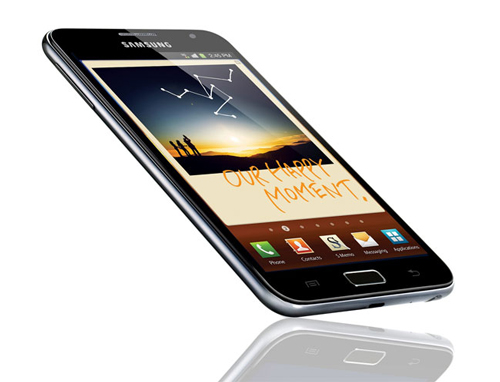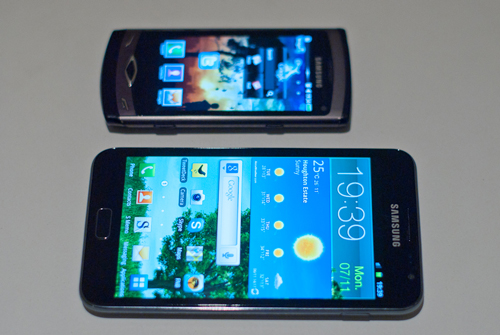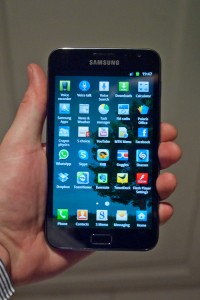
There’s simply no getting away from it: the Samsung Galaxy Note is huge!
With 5,3 inches of screen real estate, it’s also quite the attention grabber. That attention elicits one of two responses. The first of these is awe and envy. The other is laughter and derision. So which is it? Is it the best phone ever, or some sort of Samsung practical joke?
The Galaxy Note is an anomaly. Just as we’ve got used to the idea of a tablet as a gap-filling device between mobile phones and laptops — a gap we didn’t know we had, mind you, until Apple invented the iPad — Samsung releases its “phablet” to bridge the gap between phone and tablet.
Samsung has also taken the novel decision to include a pressure-sensitive stylus that slots into the bottom of the device and allows users to take notes, draw or sketch, and annotate any screenshot. Screenshots are produced in a couple of ways, the most entertaining of which is via the “judo swipe” which entails sliding the side of your hand across the screen.
The stylus functionality appears to be one of the features Samsung most wishes to highlight, and to those for whom that sort of thing is useful it’s definitely a great feature. Unfortunately, however, when taking notes there is a small amount of lag between moving the stylus and the input registering on the display.
Though this delay is less of an issue while drawing or scribbling a word or two on a screenshot of a map or similar, with the Note being punted as a digital notebook it’s frustrating because generally it can’t keep up with the speed at which most people write.
Also, it’s worth asking whether the stylus is going to be perceived as a feature or gimmick by the majority of consumers. Other than the Flyer — HTC’s 7-inch tablet — we haven’t seen many products with a stylus in recent years and there is little to suggest that it’s a feature for which consumers hanker after.

Nevertheless, the stylus is a novel inclusion and the fact that it fits into the device is a far more elegant solution that HTC’s decision to include a case with the flyer that can store the stylus via a tag on its side. Some will find it the best reason for getting the device; others may not even realise it’s there.
Despite its enormous, 5,3-inch, 1280×800-pixel high-definition Super Amoled display, the Galaxy weighs a diminutive 178g and is only 9,7mm thick, meaning it fits in most pockets and is pretty discreet for a phone that, when in use, makes curious passersby ask if it’s real.
In fact, considering its size, it’s amazingly compact and portable and we found it slipped into a breast pocket as easily as a trouser pocket. The problem comes when you take it out to use it. Frankly, it feels distinctly like you’re making a call on a tablet computer.
Though we loved the ability to type as easily in portrait orientation as in landscape, and the Note’s Amoled display is the best screen we’ve ever seen on a phone, we had a hard time reaching icons on the far left or right of the screen while using one hand.
The result is that one often has to use two hands — one to hold the Galaxy Note and the other to operate it. Though that’s a good thing for discouraging people from using their handsets while driving, it also means those who won’t be discouraged will be even more dangerous behind the wheel.
When it comes to performance, however, the Note simply cannot be faulted. With a dual-core, 1,4GHz ARM Cortex-A9 processor beneath the bonnet and 1GB of RAM, the Note simply flies. Flipping between home screens or running applications is effortless and, despite our best attempts, we couldn’t seem to get it to run at any speed other than blistering.

Being a top-end device, the Note has all of the connectivity support and common smartphone features you’d expect — from an accelerometer to support for all major Wi-Fi protocols, including the ability to transfer data over Wi-Fi or use the device itself as a hotspot.
The Note runs Google’s Android operating system (2.3, Gingerbread), with Samsung’s TouchWiz user interface overlay. On the whole, Samsung’s additions are some of the least offensive of the Android variations, but there remain a couple of annoyances.
One of these, for example, is that it takes four selections to delete a text message. Rather than having the option to delete onscreen when viewing messages users are forced to open the options menu, then select “more”, then opt to delete the message and finally to confirm the deletion. For something that most people are likely to do often it’s a real nuisance.
The Note will be available in SA in the 16GB variety — there’s no word yet on whether we can expect its 32GB sibling — and this can be expanded by an additional 32GB via a micro SD card. This means there is plenty of space for applications, images and even video, the last of which is particularly good on the Note’s incredible display.
Similarly impressive is the Note’s eight megapixel camera and LED flash. Images are sharp and crammed full of detail, and the Note’s screen makes them look incredible. The camera also shoots 1080p video at 30 frames a second and the results are impressive for a phone. The front-facing camera, meanwhile, is a respectable two megapixels and handles video calling admirably.
Samsung’s “Voice Talk”, a more primitive Apple Siri-type product, handles simple commands like “call so-and-so” with aplomb but it has a harder time dealing with complicated queries or dictated messages. Like Siri it requires a data connection to work. Voice functionality still has a long way to go, at least in when it comes to Android.
Battery life is another negative for the Galaxy Notes. In an effort to keep the weight down, the Note seems to share the battery of the far smaller Galaxy S2. Consequently, battery life, while not abysmal, isn’t exactly stellar. In standby mode the phone lasts for days but half an hour of use and that enormous screen gives the battery a knock. You may find yourself having to charge it before the day is up.
Samsung promo for the Galaxy Note (via YouTube):
http://www.youtube.com/watch?v=bfMmMrUwRnI
In summary, the Samsung Galaxy Note is a polarising device: some people who lay eyes on it want to order one immediately (that’s how we felt at first); others point and laugh and make disparaging remarks about it being akin to a fat girl who’s terribly bright but with whom you’re still a little embarrassed to be seen (which is a closer approximation of how we feel after several days with it).
If you want a huge, high-resolution and fantastically crisp and contrast-rich screen, the Samsung Galaxy Note is undoubtedly the best device in its class. It’s also great if you like the attention of strangers, many of them geeky. And if performance is paramount and you feel a tablet is insufficiently portable, you’re going to love the Note.
The shy, small-pocketed, or thrifty will find much about the Note they won’t like. At around R8 500, it’s not the sort of device one acquires via an impulse purchase (unless money is no object). If you’re looking for subtlety, look elsewhere. But if you’re looking for sheer computing power and the biggest, brightest and best screen money can buy, you’ve just found your next phone. — Craig Wilson, TechCentral
- Subscribe to our free daily newsletter
- Follow us on Twitter or on Facebook
- Visit our sister website, SportsCentral (still in beta)




